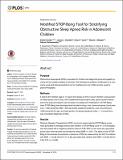| dc.contributor.author | Combs, Daniel | en_US |
| dc.contributor.author | Goodwin, James L. | en_US |
| dc.contributor.author | Quan, Stuart F. | en_US |
| dc.contributor.author | Morgan, Wayne J. | en_US |
| dc.contributor.author | Parthasarathy, Sairam | en_US |
| dc.date.accessioned | 2015-12-04T18:13:04Z | |
| dc.date.issued | 2015 | en_US |
| dc.identifier.citation | Combs, Daniel, James L. Goodwin, Stuart F. Quan, Wayne J. Morgan, and Sairam Parthasarathy. 2015. “Modified STOP-Bang Tool for Stratifying Obstructive Sleep Apnea Risk in Adolescent Children.” PLoS ONE 10 (11): e0142242. doi:10.1371/journal.pone.0142242. http://dx.doi.org/10.1371/journal.pone.0142242. | en |
| dc.identifier.issn | 1932-6203 | en |
| dc.identifier.uri | http://nrs.harvard.edu/urn-3:HUL.InstRepos:23845123 | |
| dc.description.abstract | Purpose Obstructive sleep apnea (OSA) is prevalent in children and diagnostic polysomnography is costly and not readily available in all areas. We developed a pediatric modification of a commonly used adult clinical prediction tool for stratifying the risk of OSA and the need for polysomnography. Methods: A total of 312 children (age 9–17 years) from phase 2 of the Tucson Children’s Assessment of Sleep Apnea cohort study, with complete anthropomorphic data, parent questionnaires, and home polysomnograms were included. An adolescent modification of STOP-Bang (teen STOP-Bang) was developed and included snoring, tired, observed apnea, blood pressure ≥ 95th percentile, BMI > 95th percentile, academic problems, neck circumference >95th percentile for age, and male gender. An apnea-hypopnea index ≥ 1.5 events/hour was considered diagnostic of OSA. Results: Receiver Operator Characteristic (ROC) curves for parent-reported STOP-Bang scores were generated for teenage and pre-teen children. A STOP-Bang score of < 3 in teenagers was associated with a negative predictive value of 0.96. ROC curves were also generated based upon child-reported sexual maturity rating (SMR; n = 291). The ability of teen STOP-Bang to discriminate the presence or absence of OSA as measured by the AUC for children with SMR ≥ 4 (0.83; 95%CI 0.71–0.95) was better than children with SMR < 4 (0.63; 95%CI 0.46–0.81; p = 0.048). Conclusions: In community dwelling adolescents, teen STOP-Bang may be useful in stratifying the risk of OSA. | en |
| dc.language.iso | en_US | en |
| dc.publisher | Public Library of Science | en |
| dc.relation.isversionof | doi:10.1371/journal.pone.0142242 | en |
| dc.relation.hasversion | http://www.ncbi.nlm.nih.gov/pmc/articles/PMC4651349/pdf/ | en |
| dash.license | LAA | en_US |
| dc.title | Modified STOP-Bang Tool for Stratifying Obstructive Sleep Apnea Risk in Adolescent Children | en |
| dc.type | Journal Article | en_US |
| dc.description.version | Version of Record | en |
| dc.relation.journal | PLoS ONE | en |
| dash.depositing.author | Quan, Stuart F. | en_US |
| dc.date.available | 2015-12-04T18:13:04Z | |
| dc.identifier.doi | 10.1371/journal.pone.0142242 | * |
| dash.contributor.affiliated | Quan, Stuart | |


